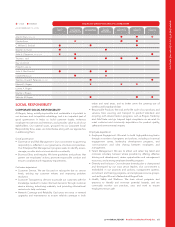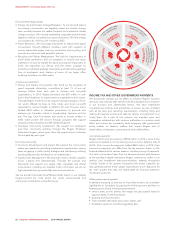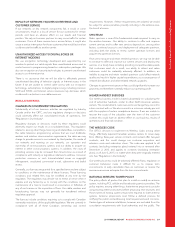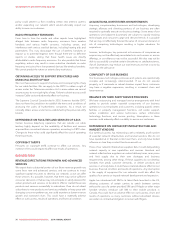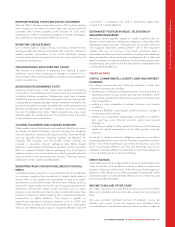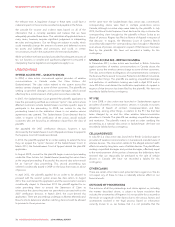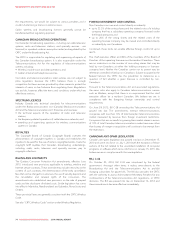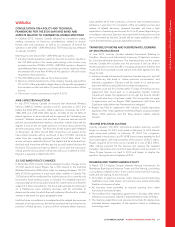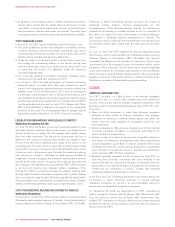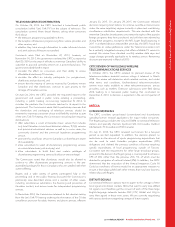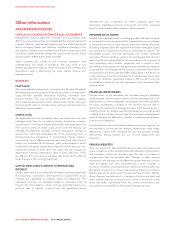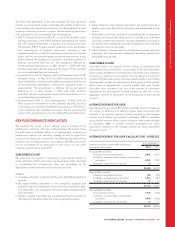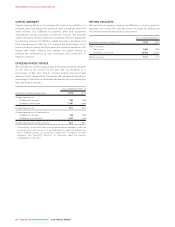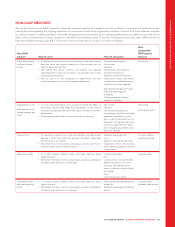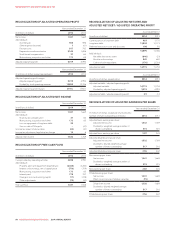Rogers 2014 Annual Report Download - page 79
Download and view the complete annual report
Please find page 79 of the 2014 Rogers annual report below. You can navigate through the pages in the report by either clicking on the pages listed below, or by using the keyword search tool below to find specific information within the annual report.
MANAGEMENT’S DISCUSSION AND ANALYSIS
WIRELESS
CONSULTATION ON A POLICY AND TECHNICAL
FRAMEWORK FOR THE 2500-2690 MHZ BAND AND
ASPECTS RELATED TO COMMERCIAL MOBILE SPECTRUM
In October 2013, Industry Canada released its consultation paper,
seeking comments on licencing considerations related to auction
format, rules and processes, as well as on conditions of licence for
spectrum in the 2500 – 2690 MHz band. The final policy was released
on January 10, 2014.
Key things to note about 2500 – 2690 MHz spectrum policy:
• Industry Canada adopted a spectrum cap (not an auction cap like in
the 700 MHz auction). No carrier participating in the auction may
possess more than 40 MHz of 2500 – 2690 MHz spectrum. Rogers is
grandfathered with respect to our holdings in those situations where
we already hold more than 40 MHz of this spectrum. We will not be
required to return spectrum.
• The 2500 MHz auction will use Tier 3 licence areas.
• Minimum rollout requirements set by Industry Canada varying from
5% to 50% of the population depending on the specific geographic
licence area must be met within 10 years of the initial issuance of the
licence.
• The auction is set to commence on April 14, 2015.
AWS-3 SPECTRUM AUCTION
In July 2014, Industry Canada announced that Advanced Wireless
Services (AWS-3) wireless spectrum will be auctioned in 2015 and
before the 2500 MHz auction. AWS-3 spectrum comprises the 1755-
1780 MHz and 2155-2180 MHz bands. 30 MHz of the 50 MHz of
paired spectrum to be auctioned will be reserved for “operating new
entrants”. Wireless carriers with less than 10 percent national and 20
percent provincial/territorial wireless subscriber market share will be
eligible to bid on the set-aside spectrum in licence areas where they
are then providing service. The final rules for the auction were released
on December 18, 2014. The 20 MHz of spectrum not subject to the
new entrant set-aside will be auctioned in two 5+5 MHz sub-blocks
rather than the originally proposed single 10+10 MHz block. The
auction will use a sealed-bid format. The highest bid for a block will win
the block and the winner will then pay the second highest bid price for
the block. The auction will start on March 3, 2015 with the submission
of bids and the announcement of winners will occur on March 6, 2015.
Payment is required on March 20, 2015.
3.5 GHZ BAND POLICY CHANGES
In December 2014, Industry Canada released its policy changes to the
3.5 GHz spectrum band. Rogers has a 50% interest in the Inukshuk
Wireless Partnership (IWP) which holds (on average) between 100-175
MHz of 3.5GHz spectrum in most major urban markets in Canada. The
3.5GHz band will be reallocated for mobile services (it is currently only
licensed for fixed wireless access in Canada). The establishment of a
new band plan and licensing framework for mobile services will be the
subject of a future consultation. The band will eventually be relicensed
on a flexible-use basis whereby licensees will be permitted to
determine the extent to which they will implement fixed and/or mobile
services in the band in a given geographic area.
Until the future consultation is completed and the related decisions are
released, all existing licences that will be renewed will be limited to the
provision of fixed services. Licences will be renewed where licensees
have satisfied all of their conditions of licence and renewed licences
will have a 1-year term. On completion of the consultation process and
release of related decisions, renewed licensees will have a high
expectation of receiving new licences for 10 or 20 years (depending on
consultation outcome). Spectrum associated with existing licences that
are not renewed by Industry Canada will be made available on a first-
come, first-served basis using an application process.
TRANSFERS, DIVISIONS AND SUBORDINATE LICENSING
OF SPECTRUM LICENCES
In June 2013, Industry Canada released Framework Relating to
Transfers, Divisions and Subordinate Licensing of Spectrum Licences
for Commercial Mobile Spectrum. The Framework lays out the criteria
Industry Canada will consider and the processes it will use when it
reviews spectrum licence transfers, including prospective transfers that
could arise from purchase or sale options and other agreements. Key
things to note:
• Industry Canada will review all spectrum transfer requests, and will
not allow any that result in “undue spectrum concentration” and
reduced competition. Decisions will be made on a case-by-case
basis and will be issued publicly to increase transparency.
• Licensees must ask for a review within 15 days of entering into any
agreement that could lead to a prospective transfer. Industry
Canada will review the agreement as though the licence transfer
that could arise from it has been made. This timing does not apply
to agreements such as Rogers’ AWS agreements with Shaw and
Quebecor made before the Framework was released.
• Rogers has filed an application with Industry Canada requesting
approval of the Shaw agreement whereby Rogers would purchase
Shaw’s AWS spectrum and the filing remains before Industry
Canada.
700 MHZ SPECTRUM AUCTION
Industry Canada’s 700 MHz commercial wireless spectrum auction
began on January 14, 2014, and ended on February 13, 2014. Results
were announced publicly on February 19, 2014. Ten companies
participated in the auction, and 97 of 98 licences were awarded to 8 of
those participants, with total proceeds of the auction of $5.27 billion.
Rogers acquired 22 licences across Canada at a cost of $3.3 billion.
After making payment for the licences and passing the required
Canadian Ownership and Control review, Rogers took possession of
these 20-year licences on April 3, 2014 and began to deploy the
spectrum during the second quarter of 2014.
ROAMING AND TOWER SHARING POLICY
In March 2013, Industry Canada released Revised Frameworks for
Mandatory Roaming and Antenna Tower and Site Sharing, concluding
a consultation initiated in 2012. It setsoutthecurrentrulesforroaming,
tower and site sharing. Its key terms are:
• All holders of spectrum licences, radio licences and broadcasting
certificates must share towers and antenna sites, where technically
feasible, at commercial rates.
• All licensees were permitted to request roaming from other
licensees at commercial rates.
• The timeframe for negotiating agreements is 60 days, after which
arbitration according to Industry Canada arbitration rules will begin.
• The roaming capabilities must provide connectivity for digital voice
and data services regardless of the spectrum band or underlying
technology used.
2014 ANNUAL REPORT ROGERS COMMUNICATIONS INC. 75


